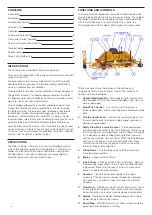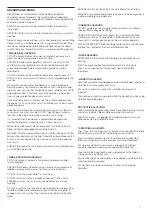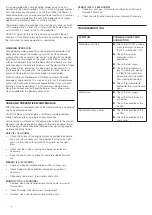
5
CUSTOMER RESPONSIBILITY
GENERAL INFORMATION
The ride-on trowel is a modern, high production machine. The
finishing rate of the unit will vary depending on the model, operator
skill and job conditions.
Please take time to familiarise all operators of the machine with the
location and function of all controls.
It is essential that your ride-on trowel is kept in a good operating
condition as this will prolong the units operational life and reduce
maintenance costs, as well as helping to identify any problems or
components which may require maintenance or replacement.
The easiest way to ensure the machine is kept in a good operating
condition is to follow the Parchem service plan and clean the unit
at the end of each day to ensure it is kept free of concrete residue.
Concrete residue that hard¬ens is very difficult to remove and is
extremely abrasive and if left to build up on the machine will quickly
degrade crucial mechanical components including the steering
mechanism, blade tilt mechanism and drive mechanism as well as
increasing machine weight and reducing efficiency.
If your ride-on trowel is fitted with a hydraulic steering the dual
joysticks are linked to three hydraulic steering cylinders. A hydraulic
pump is coupled to the engine to deliver a controlled flow of
hydraulic fluid to the steering cylinders. The hydraulic fluid level
must be maintained and the hydraulic system including hoses,
pump, filters and valve block must be inspected regularly to ensure
there are no leaks and all hoses and fittings are in good condition.
Failure to conduct preventative maintenance on these items may
result in a hose failure, hydraulic system failure and loss of steering.
We recommend that prior to starting the trowel the items listed
under ‘each use’ on the preventative maintenance schedule
are checked. These include the following items: Engine oil level,
cooling system level, hydraulic oil level, gearbox oil level, fuel level,
deadman switch operation, throttle pedal operation, steering
control operation, belt tension, spider plate lubrication, condition of
blades
The minimum maintenance requirements required on machines are
listed in the Parchem service plan.
PRE-DELIVERY INSPECTION.
A pre-delivery inspection service has been completed by Parchem.
The operation of specific items including: controls, motor &
transmission, moving & fixed parts have been inspected and
tested prior to the delivery of your machine and adjustments and
corrections have been made where necessary.
INITIAL INSPECTION REQUIREMENTS.
After your machine has been operated for 25 hours or a period of
one month, you are requested to return it to the Parchem branch
from where it was purchased for the 25 hour inspection service.
Note that the inspection service should be completed within 2
months from the date of sale. Please book your machine with
a Flextool service co-ordinator to arrange for the no charge 25
hour inspection service. If the inspection service is due while the
machine is in operation or the machine is being operated in a
different State to which it was purchased in, please contact your
sales representative to organise the inspection service at the next
available opportunity at the closest Parchem branch.
TRANSPORTER TROLLEY OPERATION
ATTACHING THE TRANSPORTER TROLLEY TO RIDE-ON
TROWEL.
1. The transporter handle must first be extended and secured to
the trolley by inserting the large hitch pin.
2. Wheel the transporter trolley into position straddling the trowel
and mate the lugs on the trowel centre plates up with the
brackets mounted on the trolley above the wheels.
3. Place one foot on the trowel lower guard ring to stop the unit
from rolling forwards and slowly using two hands, pull the
transporter trolley handle towards the operator, keeping a
secure grip on the handle at all times.
4. Once the wheels have taken up the full weight of the unit,
the handle can continue to be lowered until the pickup bar
touches the ground. With a foot still on the guard ring the
operator must keep one hand applying downward pressure
on the handle, while the other hand may be used to locate the
pickup bar between the lugs mounted on the lower guard ring
and secure it using the short hitch pin.
5. The Ride-On trowel may now be moved safely by the
operator.
DETACHING THE TRANSPORTER TROLLEY FROM RIDE-ON
TROWEL.
To avoid serious injury the pickup bar hitch pin must NEVER be
removed without the operator having one foot placed on the guard
ring so it is touching the ground and one hand maintaining a secure
grip on the handle ‘T’ bar.
1. Once the operator has taken up the position with one foot
placed on the guard ring so it is touching the ground and
one hand maintaining a secure grip on the trolley handle, the
operator can remove the hitch pin.
2. With the hitch pin removed the operator with one foot still on
the guard ring may now place the free hand on the handle
and slowly raise the handle while still maintaining downward
pressure. At this point the handle will try to catapult forward so
the operator must exercise extreme care and use their body
weight to restrict the forward momentum of the handle, until
the trowels weight is no longer being supported by the trolley
and the trowel is resting level on the ground.
3. The trolley may now be removed from the unit.
PITCHING THE BLADES
To pitch the blades upward, turn Pitch Control Knob clockwise.
To lay the blades flat, turn the knob counter-clockwise. The pitch
adjustment feature of the trowel permits quick and accurate pitch
changes of the trowel blades without having to stop the machine.
By adjusting pitch to suit varying conditions over the slab surface,
the operator can do the work faster and achieve a better slab
finish.
FLOATING OPERATION
For floating and finishing operations, guiding the trowel on the
slab is simple: a slight upward lift of the handle causes the trowel
to travel to the left. Holding the handle in a neutral position leaves
the trowel rotate in one spot. Slight downward pressure on the
handle causes the trowel to travel to the right. A slight twist to the
right will move the trowel forward, and a twist to the left will move it
backward.
To achieve quality slab finish, the operator should start floating
operation at the right time. This can be determined by using a
footprint test. If the operator steps onto the slab and leaves a
3 mm impression on the surface, then it may be ready for the
floating.








